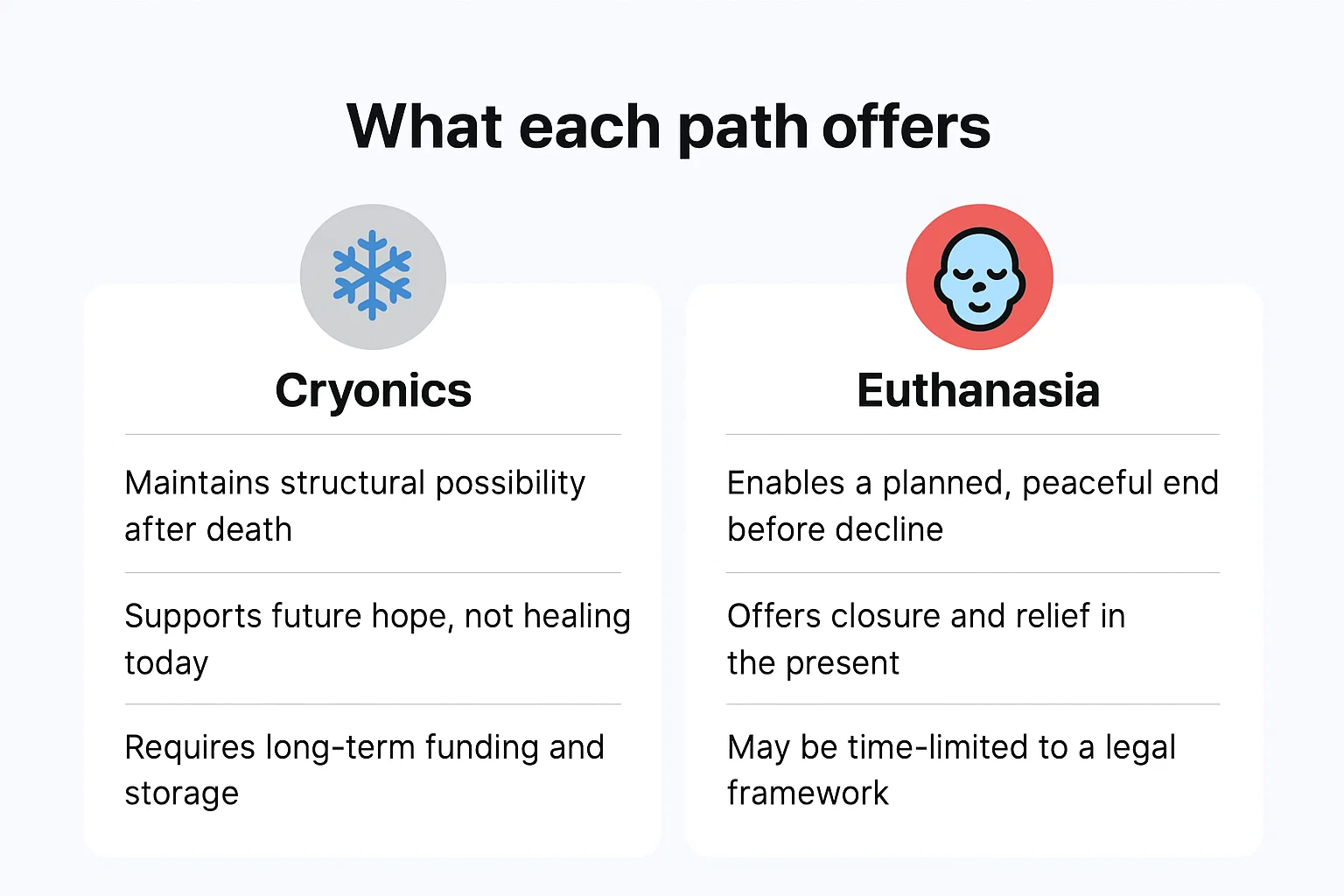Cryonics vs. euthanasia: a controversial comparison
Conversations about life’s final chapter can be deeply personal and painful. Two paths, cryonics and euthanasia, often come into focus for people dealing with serious illness. One aims to pause possibilities, the other to control an ending. Both raise profound questions about dignity, trust, and meaning. This article dives past the surface, looking at how each choice reflects our values and what they offer those navigating end-of-life decisions.
Fundamental differences in purpose
At the heart, cryonics and euthanasia serve opposite hopes:
Euthanasia is a choice to end suffering with purpose and control. It’s about saying goodbye with clarity.
Cryonics preserves someone after legal death, not to end suffering, but to maintain the option, to preserve identity and structure in case science ever offers revival.
These choices arise from different concerns, and neither is “better.” Context, personality, hope, and resources shape which path might resonate most.
Emotional dynamics at the end of life
The human heart is central in both decisions:
- In euthanasia, the core emotion is relief, ending pain or decline as dignified and timely.
- In cryonics, it’s a blend of hope and uncertainty, keeping identity alive when current care reaches its limits.
Ethical dimensions and decision-making
Both choices carry serious ethical weight:
- Euthanasia demands conviction that life is no longer bearable, drawing on legal, medical, and emotional safeguards.
- Cryonics raises questions about consent, financing, and accessibility, preserving hope in ways that few can yet realize, and structuring funding (often via life insurance) for long-term care.
Key ethical principles, autonomy, compassion, realism, must guide both paths with transparent conversation and deep empathy.
Practical considerations and planning
Each option requires careful preparation:
Euthanasia planning: Often involves legal steps, consulting professionals, and ensuring emotional and physical comfort.
Cryonics preparation: Involves standby readiness, legal clarity (advance directives, insurance), and logistical coordination for stabilization after legal death.
Both decisions involve loved ones, legal guidance, financial planning, and sometimes, both coexist in someone's careful end-of-life roadmap.

When one choice may lead to another
Some see a bridge between both:
- A person may choose palliative care now, and also plan for cryonics later.
- In progressive illness, euthanasia may feel like preserving autonomy when suffering becomes intolerable.
- Others may choose neither, seeking natural passing, comfort, and presence in life's final chapter.
No answer is universal, only deeply personal.
Holding space for the conversation
Making these choices requires courage, and love. Ask:
- What matters most right now, comfort, clarity, hope?
- What will bring meaning to the end of life for that person and their circle?
- What resources, financial, supportive, spiritual, are needed?
There are no simple answers. But honesty, empathy, and sincerity guide the way, even in controversial terrain.
Cryopreservation with compassion
Cryonics isn’t a cure. It’s a choice, a gesture of respect for identity, for possible futures, for personal agency when current options end.
If you’re considering cryopreservation, whether alongside or instead of end-of-life choices, we offer compassionate clarity, not persuasion. We know how challenging a terminal diagnosis can be. We’re here to explain how it works, what’s involved, and how it may align with your values.
Final reflections
Cryonics and euthanasia may stand at different ends of the end-of-life spectrum, but both reflect a shared desire: to act on our own terms.
- Cryonics preserves the possibility of tomorrow.
- Euthanasia honors the dignity of a chosen ending.
- Ultimately, the best choice is the one that reflects your beliefs, priorities, and the legacy you want to leave.
If this article brings up questions, about timing, logistics, or what feels right, reach out. We’re here to walk beside you, with respect and clarity.
About Tomorrow.bio
At Tomorrow.bio we are dedicated to advancing the science of cryopreservation with the goal of giving people a second chance at life As Europe’s leading human cryopreservation provider we focus on rapid high-quality standby, stabilization and storage of terminal patients preserving them until future technologies may allow revival and treatment.
Our mission is to make human cryopreservation a reliable and accessible option for everyone We believe that no life should end because current capabilities fall short.
Our vision is a future where death is optional where people have the freedom to choose long-term preservation in the face of terminal illness or fatal injury and to awaken when science has caught upInterested in learning more or becoming a member
📧 Contact us at hello@tomorrow.bio
🌐 Visit our website www.tomorrow.bio
🤝 Schedule a call with our team Book a consultation



